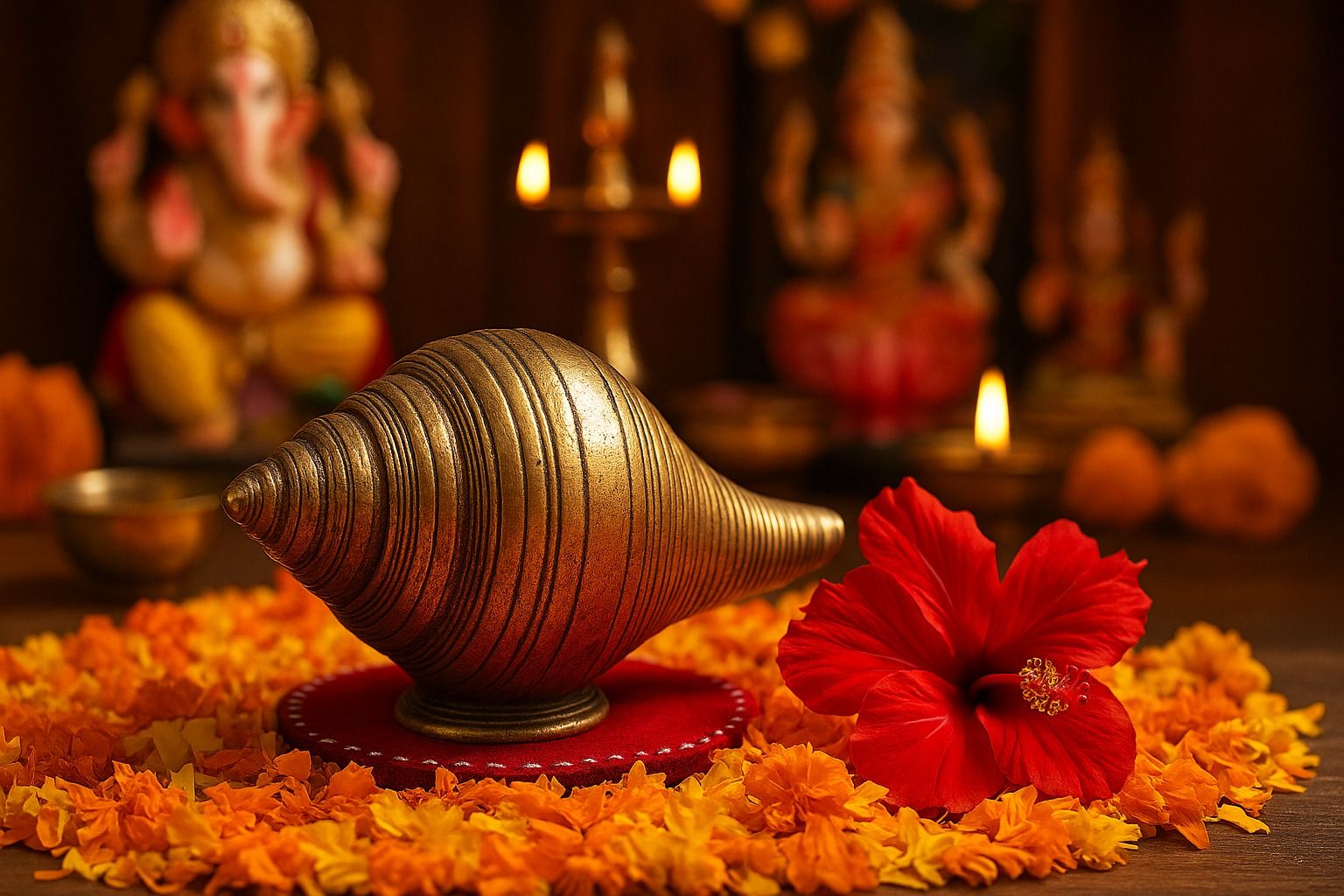
The Shankha: Sacred Symbol of Sound, Purity & Power
In the vast and vibrant world of Hindu spirituality, the Shankha (conch shell) holds a unique and sacred place. More than just a physical object, the Shankha is a symbol of auspiciousness, divine sound, protection, and purity. From being blown during pujas to being held in the hands of deities like Vishnu and Lakshmi, the Shankha is deeply woven into Indian culture and rituals.
In this blog, we explore the spiritual meaning, history, usage, types, and benefits of the Shankha, and why it continues to resonate across temples and homes even today.
By Team BookMyPooja
🕉️ What is a Shankha?
The Shankha is a naturally occurring spiral shell formed from marine mollusks. Traditionally white or cream in color with a rightward or leftward spiral, it has been revered in Hinduism, Buddhism, and Jainism for thousands of years.
The word "Shankha" comes from Sanskrit, where “Sha” means "auspicious" and “Kham” means "water" — thus symbolizing sacred water and purity.
🌟 Spiritual Significance of the Shankha
- Symbol of the Omkara (Pranava Naad)
- The sound of the conch is said to resemble Om, the primordial sound of creation.
- Blowing the Shankha during aarti or puja purifies the environment and the mind.
- Weapon of Lord Vishnu
- Lord Vishnu, the protector of the universe, holds the Panchajanya Shankha in one of his four hands.
- The conch signifies victory over evil, cosmic order, and divine authority.
- Lakshmi’s Symbol of Wealth
- Goddess Lakshmi, the consort of Vishnu and the goddess of fortune, is often depicted with a Shankha.
- It is considered to attract wealth, peace, and blessings when kept in the home.
- Temple and Puja Essential
- Almost every Hindu temple or household altar has a Shankha.
- It is blown during mangala aarti, havan, yagna, and housewarming ceremonies.
📜 Historical and Scriptural References
- In the Bhagavad Gita, during the Kurukshetra war, Krishna blew his divine conch Panchajanya, Arjuna blew Devadatta, and Bhima blew Paundra — each representing divine power and righteousness.
- The Vishnu Purana mentions the Shankha as emerging from the ocean during the Samudra Manthan (churning of the cosmic ocean).
- Ayurveda and Tantra recognize the Shankha as a tool of sound healing and energy purification.
🌀 Types of Shankhas and Their Uses
1. Dakshinavarti Shankha (Right-Turned Conch)
- Spirals to the right (clockwise)
- Considered very rare and highly auspicious
- Associated with Goddess Lakshmi
- Used for wealth, prosperity, and positive vibrations
- Typically not blown; kept in the altar or cash box
2. Vamavarti Shankha (Left-Turned Conch)
- Spirals to the left (anticlockwise)
- Most common and used for blowing during puja
- Represents Lord Vishnu
- Used in daily rituals and purification ceremonies
3. Ganesha Shankha
- Shaped like Lord Ganesha’s face
- Brings removal of obstacles and success
4. Gaumukhi Shankha
- Resembles a cow’s mouth
- Considered sacred and ideal for milk abhishekam
🕯️ Rituals and How to Use the Shankha in Worship
📿 1. Blowing the Shankha
- Before starting puja, blow the Shankha 3 times to announce the beginning of sacred rituals.
- The sound destroys negative energies, attracts divine forces, and activates chakra energy.
💦 2. Storing Holy Water
- Some Shankhas are filled with Ganga Jal or purified water and sprinkled on devotees and idols.
🛁 3. Abhishekam (Ritual Bathing)
- Water poured from a Shankha during abhishekam is considered more potent and spiritually charged.
📍4. Placement in Home
- The right placement of Shankha in the pooja room or northeast corner invites abundance and positivity.
- Keep the Dakshinavarti Shankha on a red/yellow cloth with kumkum and rice grains.
✨ Scientific and Health Benefits of Shankha
1. Sound Healing
- The sound vibrations from the Shankha are known to stimulate brain function, calm the mind, and relieve stress.
- It has therapeutic effects similar to pranayama and mantra chanting.
2. Positive Energy Flow
- The spiral shape of the Shankha balances Vaastu energy, especially when placed in offices and homes.
3. Natural Antiseptic
- Water kept in a real conch overnight is said to acquire alkaline and antiseptic properties, helpful for digestion and immunity.
📌 Do's and Don'ts with the Shankha
✅ Do's:
- Clean the Shankha regularly with clean water and a soft cloth.
- Blow it only after taking a bath, in a clean and pure state.
- Use separate Shankhas for blowing and for puja water.
❌ Don’ts:
- Never use the same Shankha for blowing and storing water.
- Avoid placing the Shankha near the feet or on the floor.
- Do not blow it during eclipse, after sunset, or during inauspicious timings.
🏡 Shankha in Vaastu and Feng Shui
- Placing a Dakshinavarti Shankha in the northeast corner of your home can:
- Improve financial flow
- Remove Vaastu dosha
- Attract peace and harmony
It is often recommended by Vaastu consultants and astrologers as a remedy for blocked luck and spiritual dullness.
📚 Shankha in Other Cultures
While the Shankha is most prominent in Hinduism, it also appears in:
- Buddhism: Symbol of the proclamation of Dharma
- Tibetan rituals: Used in chants and prayers
- Ancient Greek and Roman: Used by sea deities like Triton
🌺 Conclusion
The Shankha is more than just a ceremonial object. It’s a representation of cosmic sound, purity, victory, and divine presence. Whether you’re a devotee looking to enhance your spiritual practices or someone interested in Indian traditions, the Shankha is a powerful and symbolic addition to your sacred space.
In today's world of stress and imbalance, even the simple act of blowing a conch daily can bring mental clarity, peace, and a deep sense of spiritual grounding.





